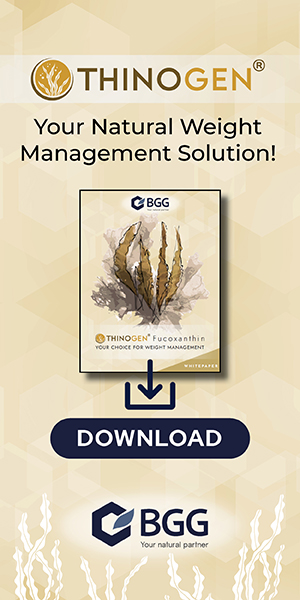Emerging technologies are transforming the natural products space, changing how research is conducted, and how companies are ideating, innovating, and commercializing products.
Technology can lead us to a more efficient, transparent, and resilient sector, maintains Gary Iles, SVP of Marketing & Business Development at TraceGains. “As supply chains become even more complex and regulatory pressures increase, businesses will need smarter solutions to stay competitive,” Iles explains. “We can leverage the power of new and emerging technologies to optimize our products and services, enhancing efficiencies that enable us to deliver significant benefits to our customers."
Research, Ideation, and Commercialization
A perfect example of AI-fueled optimization is the research realm. The team at Radicle Science has a goal of creating “an abundant future of proven, personalized wellness that is accessible to all,” and tech has made the difference. “We knew that achieving this mission required generating rigorous health data from large, diverse populations—because true health equity starts with health data representative of us all,” says Pelin Thorogood, Co-Founder and Executive Chair of Radicle Science. “This approach not only ensures inclusivity, but also unlocks the power of personalized wellness. To make this vision a reality, we first launched Radicle Discovery, our flagship offering that redefines clinical research. By combining gold-standard, double-blind, randomized, placebo-controlled trials with an AI-driven virtual approach, we generate clinical evidence with unprecedented speed, scale, and affordability. AI is integral to this process—transforming vast, multidimensional health data into precision insights.”
AI fuels hypothesis generation, identifies consumer subgroups more likely to benefit, and predicts treatment responses, says Thorogood. “Biostatistical validation of these hypotheses ensures that our findings meet the highest scientific and regulatory standards while remaining clinically relevant. This dynamic interplay reveals how wellness interventions may impact different populations based on demographics, lifestage and lifestyle, providing powerful precision insights to inform R&D and target marketing.”
Nutriventia also makes use of AI to optimize clinical data analysis. “We do not rely on AI blindly,” says Rajat Mittal Shah, Cofounder of Nutriventia. “We use it strategically to augment human intelligence, significantly reducing time spent on research-heavy tasks.”
Previously, scientists had to manually comb through mountains of research papers, clinical trial results, and regulatory documentation, and that process took weeks or even months to complete. “Now, with AI-powered tools, we can summarize, cross-reference, and extract key insights in hours,” says Shah. “This efficiency doesn’t just help our internal teams; it means we can develop and refine our products much faster, bringing cutting-edge, scientifically validated solutions to our customers and consumers at an unprecedented pace.”
For idea generation, Nutriventia’s Shah shares, “Just like Google search changed how we accessed information, AI is obliterating the old way of looking for insights. We use it to analyze the competitive landscape, explore clinical trial design options, and refine consumer engagement strategies—transforming a traditionally slow, iterative process into a dynamic, data-driven approach. However, the real magic lies in the fact that AI doesn’t replace our scientists, formulators, or marketers—it frees them to focus on high-value, creative, and strategic work rather than repetitive tasks. For our customers and consumers, this means faster innovation cycles, well-researched and validated ingredients, and products designed with a deeper understanding of market needs. The bottom line? AI is not replacing human expertise—it’s amplifying it.”
NutrifyGenie, an AI platform from Nutrify Today, also is making waves with its facilitation of product concepts from idea to full-scale commercialization and end-to-end business development. NutrifyGenie takes the process beyond ideation by integrating the entire value chain needed for product development and commercialization, says Amit Srivastav, Founder of Nutrify Today. “This ability has allowed us to bring several innovative products to market in record time, helping our partners secure new market segments traditionally dominated by larger pharmaceutical players.” In addition, with its database of over 3.5 million data points, the NutrifyGenie AI program is able to offer real-time insights for easy regulatory compliance and strategic market launches.
IngredientAI also helps on this front. The generative AI company, started by the co-founder and CTO of Care/of, helps supplement brands, suppliers, and manufacturers develop and launch new products sooner and faster with AI-powered formulation research, ingredient discovery, claims substantiation, dossier generation, and more.
Another tech-based helper is TraceGains Gather, a networked ingredients marketplace that connects ingredient suppliers with brands and manufacturers. Iles says the platform is redefining how brands, manufacturers, and ingredient suppliers collaborate. “One way to think of our platform is as ‘LinkedIn for ingredients’ as it offers a seamless digital hub where companies can instantly access verified ingredient data and compliance documents – connecting the supply chain on a central portal for seamless communication and centralized documentation management," Iles explains. "The platform also gives brands sustainability insights at an ingredient level as well as identifying those suppliers that participate in sustainability initiatives with automated ESG data collection. Centralizing all this information enables teams to work collaboratively, utilizing the same master data and avoiding silos and different data sets. This could eliminate inefficiencies, speed up sourcing, and reduce compliance headaches."
On the regulatory side, Apex Compliance, developed by regulatory expert Asa Waldstein, alerts users to high-risk terms and phrases found on their websites, YouTube channels, social media, and other content such as images, PDFs, blogs, and videos, then offers alternative lower-risk suggestions. “Regulatory reviews that used to take hours can now be conducted more efficiently and comprehensively in minutes,” says Waldstein. “This platform not only saves time when reviewing marketing content, but also serves as a teaching tool that helps build in-house regulatory expertise.”
Iles notes that regulatory complexity is one of the biggest challenges in the food and beverage industry. "Whether it’s FSMA in the U.S., EU food safety regulations, or ESG reporting requirements, staying compliant can feel like an uphill battle. To deal with this, we’ve built compliance automation into our platform. Businesses can automate COA analysis and corrective actions, access the latest ingredient certifications, track supplier performance, and receive real-time alerts on supply chain risks and regulatory changes. Here, our partnership with SGS Digicomply, the world’s leading source of global intelligence, provides an unrivaled resource for global regulatory data. The platform is easy to navigate with exact search capabilities and highly customizable filters, allowing fast access to specific ingredient legislation or rules. This means our customers can quickly find the regulations they need, saving time and mitigating risks before they become costly problems."
Another innovative initiative comes from Radicle. “Expanding on our commitment to data-driven wellness, we recently launched Journey by Radicle Science, the first health impact tracker for wellness brands,” Thorogood says. “Built on our award-winning Proof-as-a-Service platform, Journey taps into the growing trend of health tracking.”
Science, the first health impact tracker for wellness brands,” Thorogood says. “Built on our award-winning Proof-as-a-Service platform, Journey taps into the growing trend of health tracking.”
Thorogood says Journey generates first-of-its-kind real-world evidence into how supplements, functional foods and beverages affect individual health, while also empowering brands to demonstrate the personalized effects of their products to purchasing consumers. “Journey digitally engages consumers post-purchase, enabling them to easily track their health, and providing them with real-time personalized visualizations of their health progress,” she says. “In turn, Journey allows brands to foster greater consumer adherence, trust, and repeat purchase, while also arming them with never-before-seen insights into the aggregate health and behavior of their consumers.” Pilot brands experienced a 20% to 30% increase in repeat purchases, proving the power of real-time, data-driven, personalized engagement, Thorogood adds. “In addition to the direct revenue impact Journey delivers, brands also receive unique behavioral and perception insights from Journey to optimize their marketing strategies and product positioning. Specifically, AI and statistical analysis of the aggregate data from consumer Journeys provides novel health insights to drive R&D, improve dosing/usage instructions, and inform target marketing.”
Helping on another front, Iles points to TraceGains’ recent acquisition of NutriCalc, a European nutritional calculation and labeling software provider that enables access to a modern product lifecycle management (PLM) and features end-to-end data and process integration, from sourcing through to labeling. Iles notes, "By equipping brands with the tools to ensure transparency and sustainability, we’re helping build consumer trust and drive positive change across the industry."
Delivery System Technologies
There have been exciting developments on this front. “Our ingredients leverage some of the most advanced delivery system technologies available, including liposomes, cyclodextrins, multi-phase encapsulation, and controlled-release beadlet technology,” says Sebatian Balcombe, MS, Medicinal Chemist, Founder & CEO, Specnova. “These systems are designed to enhance ingredient performance primarily by improving bioavailability. For years, we have been at the forefront of these technologies, investing significant time and resources to understand, characterize, and validate them rigorously. Rather than relying on unverified claims, we provide full transparency through comprehensive testing protocols and complete ingredient dossiers, ensuring that customers know exactly what they are getting. This level of validation not only builds trust but also ensures that the efficacy of our ingredients is backed by data. Downstream, the benefits are tangible: improved absorption, reduced gastrointestinal distress, and the ability to achieve the same results with smaller doses. This leads to better consumer adherence, potential cost savings, and an overall superior user experience compared to conventional ingredient forms.”
At Vitaquest International, says Gregory Drew, VP of Innovation, the focus is on creating new technologies regularly by partnering with vendors and customers. “Our ability to shorten CPG commercialization cycles from multiple years to under six months is unheard of for most manufacturing businesses.”
As an example, Drew points to fluid bed technology, a process that uses highly controlled air flow at varied pressures and temperatures to modify the physical characteristics of ingredients and products. “Using fluid bed technology, we can convert multiple ingredients into single ingredient systems with uniform appearance, flow and function ready for consumer packaging or for further processing,” Drew explains. “Another example is using microencapsulation to stabilize otherwise unstable ingredients. By microencapsulating or ‘coating’ particles, the coated particles take on the properties of the coating versus the core material. Microencapsulated powders have a barrier that is intended to protect the core material from degradation or premature function, or sometimes for flavor enhancement. Through continued investment in our people, operations and Quality Assurance, Vitaquest’s ability to develop new and optimized products is unique in health product manufacturing.”
5 Keys With Emerging Tech
There’s so much to be gained, but caution is required.
Demand validation: “A key caution for companies adopting new technologies is the risk of relying on systems they haven’t developed or fully vetted,” Balcome says. “Without direct involvement in the development process, companies often lack the technical expertise to properly qualify or validate the technology they are using. This is a significant issue in the natural products industry, where some ingredient companies function primarily as distributors rather than innovators. When a company hasn’t built or deeply studied the technology themselves, they often lack the ability to critically assess whether it performs as claimed. This leads to a cycle where unverified or misrepresented technologies enter the market, creating inconsistency in product performance and eroding trust. Companies must take the time to understand the underlying science and demand rigorous validation. Without this due diligence, they risk offering products that fail to meet expectations or deliver meaningful consumer benefits.”
Try before you buy: “We urge companies that embrace new tech to try before you buy,” says Akash Shah, Co-Founder and CEO of IngredientAI. “Check the work and make sure it’s trustworthy before committing. We can’t afford to make mistakes in our industry.”
Set guardrails: “Embracing AI and other emerging technologies comes with incredible opportunities, but also with a responsibility to use them wisely,” says Nutriventia’s Shah. “One of the first things we established at Nutriventia was an AI usage policy—clearly defining what tools are permissible, under what licenses, and ensuring our teams are trained to use them effectively. Without such guardrails, companies risk exposing themselves to compliance issues, data privacy concerns, and misinformation. Having spent more than two decades in software development—including building my own tech startup that provided solutions for academia before transitioning into handling technology for pharma—I’ve seen how quickly tech evolves and how important it is to stay ahead of both its advantages and risks.”
Plays devil’s advocate: One of the biggest misconceptions about AI, Nutriventia’s Shah says, is that it can completely replace human thinking. “It can’t—and frankly, that’s a relief. AI still requires oversight, contextual understanding, and ethical judgment. I like to say, ‘Garbage in, garbage out’—AI is only as good as the input it receives. If used without scrutiny, it can propagate biases, reinforce misinformation, or provide incomplete perspectives. That’s why we use AI not just as a search engine, but as both a supporter and a devil’s advocate—constantly challenging it to offer multiple angles on an issue rather than accepting a single viewpoint.”
Keep evolving: “Since AI tools evolve rapidly, what is effective today may need reevaluation tomorrow, Shah adds. “Keeping a pulse on advancements, reassessing policies, and ensuring employees are continuously trained will be key to long-term success. At the end of the day, AI is a powerful tool—but like any tool, its effectiveness depends on the skill and wisdom of the people using it.”
The bottom line: “We live in exponential times, where rapid technological evolution is inevitable,” says Thorogood. “My biggest advice to companies embracing new technologies is to stay agile, continuously monitor advancements, and choose partners wisely. Change isn’t a question of if—it’s a matter of when—so it’s essential to collaborate with mission-aligned partners who see technology not as an end in itself, but as a tool to enhance and elevate the entire ecosystem. By leveraging technology as an enabler and amplifier, companies can navigate shifts effectively while driving meaningful, sustainable impact.” WF










